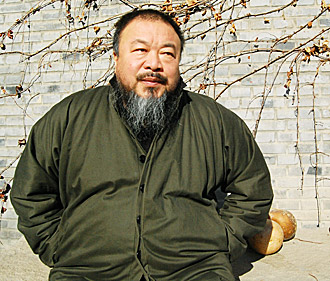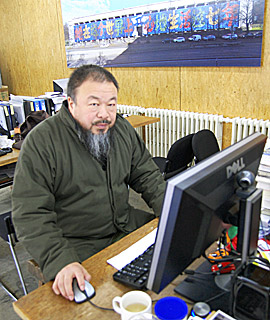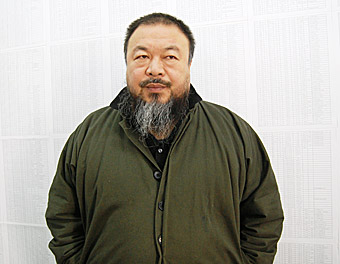Ai Weiwei - China's Revolutionary Artist
Famous sculptor, photographer and the architect who helped create the iconic Bird's Nest Stadium for the 2008 Olympics, Ai Weiwei has seen his works shown, and lauded, in the top museums and galleries around the globe. He could be China's most celebrated artist - but instead is banned from the Chinese media and has lately been beaten by authorities, and seen his studio in Shanghai razed. Still, this revolutionary artist refuses to give up his fight for democracy and human rights in his homeland.
By Ron Gluckman/Beijing, China
HE
MAY NOT BE CHINA'S MOST FAMOUS
 Still, Mr Ai, 53, is undoubtedly China’s most
outspoken artist. He claimed that honor in 2008. When the rest of China was
cheerleading the Olympics, the man largely responsible for its symbol – the
iconic Bird’s Nest Stadium – stirred a tempest by insisting there was nothing to
celebrate. He accused China of a global charade, showcasing modern facilities
and its economic might, while depriving its own people of dignity and basic
rights. He termed it a fake coming out-party, coining an alternate slogan to
Beijing’s global welcome: “Pretend smile.”
Still, Mr Ai, 53, is undoubtedly China’s most
outspoken artist. He claimed that honor in 2008. When the rest of China was
cheerleading the Olympics, the man largely responsible for its symbol – the
iconic Bird’s Nest Stadium – stirred a tempest by insisting there was nothing to
celebrate. He accused China of a global charade, showcasing modern facilities
and its economic might, while depriving its own people of dignity and basic
rights. He termed it a fake coming out-party, coining an alternate slogan to
Beijing’s global welcome: “Pretend smile.”
Mr Ai himself doesn’t smile much, if ever. Much of his days are spent listening to the pain of fellow citizens. When we meet in mid-January in his arts studio north of Beijing, he’s seated at a long wooden table with five Chinese visitors, sipping tea to stave off the intense cold. “I probably spend 30 percent of my time meeting with people, whose wife has vanished, or son is missing, or been arrested, without evidence. They tell me about their problems, things they should really tell officials. But nobody else is listening.”
He spends six to eight hours each day online, largely on Twitter. His blog was long ago blocked. “I’m totally banned in China. Nobody can talk about me or my work,” he says, stroking his signature beard. His doughy round face reassembles itself into something resembling a grin as he adds: “At least, not officially.”
When Mr Ai was detained last November, the news echoed around the world, practically in real time. “The internet is a miracle,” Mr Ai says more than once. “It is the thing that will change China, definitely. Of that, I have no doubt.”
All this leaves him scant time for art, yet hasn’t hampered what has been a meteoric career. He mounted over a dozen shows last year, including a buzzed about exhibit at London’s Tate Modern (continuing through May 2011) that features 100 million porcelain sunflower seeds, individually crafted by 1,600 workers over 18 months. He has two major shows on the way soon, a lifetime celebration of his photography in Switzerland, and an exhibit of his architecture in Austria. Mr Ai who seems to cram 50 hours into every day, is also among China’s most well-known architects and photographers.
That he can achieve all this, without much time for meetings or promotion, is all the more astonishing since much of his fame comes from concept art. This usually requires near-total immersion and constant hype. Of course, Mr Ai is helped by the fact that China keeps him in the news.
 When we meet, Mr Ai is again trending around the globe. He’s just back from
Shanghai, where authorities demolished his $1 million studio that local
officials had begged him to build. They wanted him to anchor a new arts
district, like Beijing’s 798, which he helped found. The plan worked; with Mr Ai
on board, other artists flocked to the new area. But the welcome mat was yanked
from under him, Mr Ai maintains, because of his social advocacy.
When we meet, Mr Ai is again trending around the globe. He’s just back from
Shanghai, where authorities demolished his $1 million studio that local
officials had begged him to build. They wanted him to anchor a new arts
district, like Beijing’s 798, which he helped found. The plan worked; with Mr Ai
on board, other artists flocked to the new area. But the welcome mat was yanked
from under him, Mr Ai maintains, because of his social advocacy.
Officials had hoped to quietly raze the Shanghai center, not risking a repeat of November’s publicity debacle. When they first told him they planned to raze the building, his response was grandly poetic – a huge farewell party. Mr Ai mischievously promised a huge river crab feast. “River crab” in Chinese sounds very much like “harmony,” the ideological buzzword of the Communist Party.
Outraged, officials confined Mr Ai to his Beijing home, guaranteeing the matter would go viral. “It’s so predictable,” he says, almost sympathetically. The party went on without Mr Ai, and 800 people showed up. “Nothing like that would have happened even two years ago,” he says. “It really shocked the whole nation.”
China is used to shocking stuff from this bold artist – Mr Ai has posed naked, smashed ancient Chinese sculpture and exhibited a series of photos of himself with middle finger extended. Looking like a homeless beggar or trash collector in tattered army greens, he commands a staff of 40, many volunteers who research causes and miscarriages of justice. He’s spent years fighting for a full accounting of the deaths of students in Sichuan’s 2008 earthquake. One of his most powerful works fills a studio wall with the names of 5,000 children. They were in 20 schools that turned to dust, as surrounding buildings stood firm, he notes. Officials refuse to investigate the apparent corruption or acknowledge these larger death figures.
Instead, they respond with repression and arrests. Several advocates have been detained. When local writer and activist Tan Zuoren went on trial, Mr Ai flew to the provincial capital of Chengdu, but was prevented from attending. “Police beat me, and I nearly died,” he says. In Germany for a subsequent art exhibit, suffering from headaches, he saw a doctor and was rushed into surgery to drain bleeding in his brain.
Critics suggest that Mr Ai uses advocacy to further his career, and hides behind the security of a foreign passport. “I’m here on a Chinese passport, like everyone else,” he responds. While he spent a dozen years in America, his was the textbook story of struggling artist. He snapped the odd picture for newspapers, but mostly survived as day laborer, often demolishing buildings. “I really had a funny feeling when I watched my studio in Shanghai go down,” he confesses. “I was sad, but I also thought, man, they really know what they are doing.”
Mr Ai’s life in New York was, by his admission, rather aimless. He returned to China in 1993, when his father became ill. Back in Beijing, he resumed a life of such leisure, his mother threatened to call the police on him. “After 12 years in the US, I came back without a diploma or green card, and no money. I was just hanging around with friends, smoking and playing poker. That’s all we did.”
 To escape the parental nagging, he fled to the outskirts of Beijing, to a
village called Caochangdi. Then bleak, it’s now one of Asia’s chic artist
colonies, along with nearby 798. “It was land nobody wanted,” he says. “When I
saw it and heard a train go by, I thought, ‘this is perfect. Nobody will ever
want to come here and develop such a place’.”
To escape the parental nagging, he fled to the outskirts of Beijing, to a
village called Caochangdi. Then bleak, it’s now one of Asia’s chic artist
colonies, along with nearby 798. “It was land nobody wanted,” he says. “When I
saw it and heard a train go by, I thought, ‘this is perfect. Nobody will ever
want to come here and develop such a place’.”
Mr Ai is famed as an architect for his starkness. Far from a cultivated style, he says it was simple necessity. “I could only build what I had money for, then it ran out.” Other artists began hankering for similar space, and many found it in the abandoned warehouses at 798. Mr Ai reckons he’s responsible for the design of perhaps 100 units around Caochangdi.
Celebrated internationally – his current exhibit at the Tate features 100 million sunflower seeds individually crafted by 1,600 workers of porcelain – Mr Ai has largely escaped a backlash against his activism. Until now. Days before we meet, he confides, his first major exhibit at 798 was abruptly cancelled. “I didn’t want to tell anyone, since these are my friends, but they say with all the controversy now, it’s just too dangerous to go on.”
Yet there is little chance he will buckle, or back down. Perhaps unapparent earlier to his parents, his veins are unquestionably filled with blood of his father, Ai Qing, an artist and celebrated poet, exiled in Mao’s purges. Ai Weiwei grew up in China’s Siberia, watching his father clean toilets.
Why put himself at similar risk? “No reason really,” Mr Ai says, mumbling into his beard. But then he rises up, adding: “I want to have a purpose, to protect the dignity of life. I feel it’s ridiculous to live in a condition where people cannot access their rights. I don’t want children to live in this situation.
“We have a responsibility, as artists, to fight for better conditions. I see freedom and justice as basic, fundamental rights for everyone. I’m just in this position to make my voice heard.” He acknowledges that his fame, and friends around the world, afford him that ability.
“But there are a million people like me in China. I don’t think they can stop us all.”
Ron Gluckman is an American reporter who has been living in and covering Asia since 1991. He interviewed Ai Weiwei for the Wall Street Journal in January 2011, for a story that appeared January 25, 2011. This is a longer version of the printed piece.
Note: In early April, on the way to Hong Kong, Ai Weiwei was taken away by Chinese authorities, and has remained in detention in an undisclosed location ever since. We extend our fondest hopes for his good health and safety, and urge you to support organizations calling for the release of Ai Weiwei.
All pictures by RON GLUCKMAN
Words and pictures, copyright Ron Gluckman
To return to the opening page and index
push here
[right.htm]
